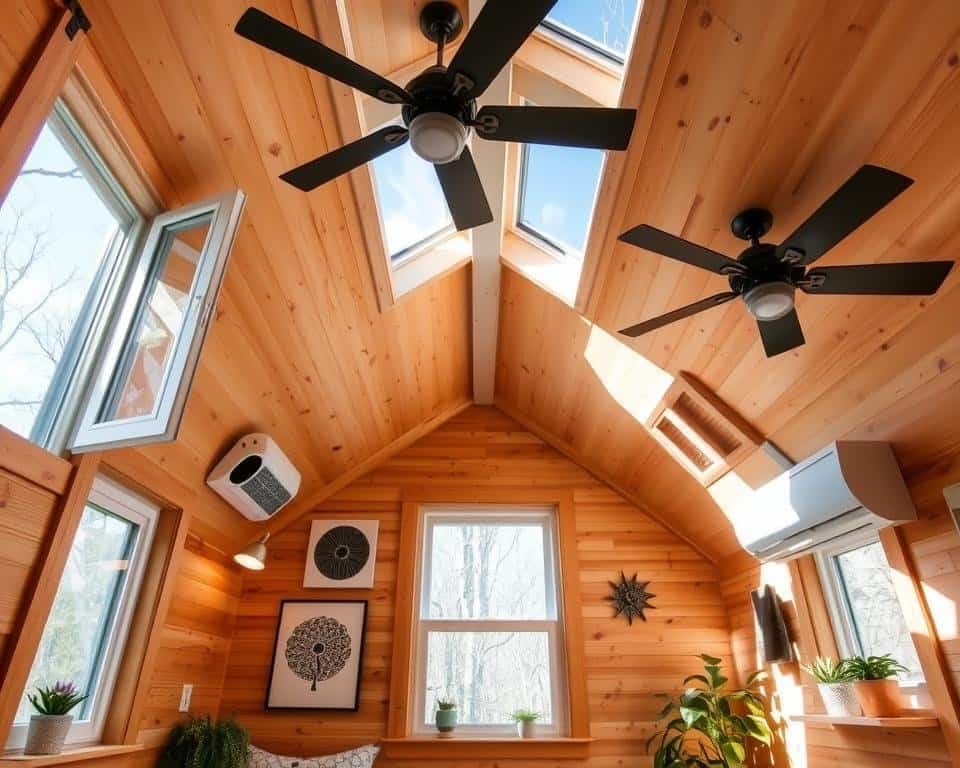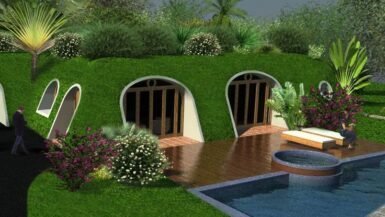Finding the right ventilation system is key for a tiny house. It keeps the living space healthy and comfy. Many struggle to choose the best ventilation for their tiny home, due to its small size.
Good ventilation removes moisture and prevents mould and mildew. It also improves air quality.

In the UK, tiny house ventilation solutions is crucial. The country’s climate can make small spaces damp and humid. It’s important to look at different ventilation options. We need to find the best one that’s energy-efficient, affordable, and effective.
Understanding Tiny House Ventilation Requirements
Ventilation is key in tiny houses. Proper ventilation keeps homes healthy and comfy. In the UK, building rules ensure tiny houses are well-ventilated and safe.
Small house ventilation systems are made for efficient ventilation in compact homes. They remove stale air and pollutants, bringing in fresh air. This is crucial in tiny houses where air can get stale.
Why Proper Ventilation Matters in Small Spaces
Good ventilation stops mould and mildew in small spaces. It also removes pollutants and allergens, making homes healthier. In tiny houses, efficient ventilation for compact homes is key for good air quality.
Building Regulations for Tiny House Ventilation in the UK
In the UK, tiny houses must follow ventilation rules. These rules ensure tiny houses have enough ventilation. Small house ventilation systems must meet these standards, making homes safe and healthy.
Common Ventilation Challenges in Compact Living
Compact living faces ventilation challenges, like limited natural ventilation. Tiny houses often need mechanical systems for enough air. But, efficient ventilation for compact homes can make living comfortable and healthy, despite these challenges.
Natural Ventilation Solutions for Tiny Houses
Natural ventilation is a top pick for tiny homes. It uses the natural flow of air to keep air fresh and remove stale air. This method is both energy-efficient and cost-effective. It works well because tiny houses often have windows, doors, and vents already.
Cross ventilation and stack ventilation are key options. Cross ventilation uses windows on opposite sides to let air flow through. Stack ventilation lets warm air rise and escape, creating a natural air flow. These methods are good for tiny homes but can be affected by weather and might let heat out.
Here are some natural ventilation solutions for tiny houses:
- Installing larger windows or adding more windows to increase airflow
- Using vents or whole-house fans to improve ventilation
- Adding a solar chimney to enhance natural ventilation
Natural ventilation is a great way to keep tiny homes well-ventilated. With a bit of creativity, it can fit the needs of small spaces. Knowing the pros and cons helps tiny house owners choose the best ventilation for their homes.
Mechanical Ventilation Options and Their Benefits
For tiny house owners, keeping the air fresh and healthy is key. Installing mechanical ventilation systems is a smart move. These systems help remove stale air and moisture, bringing in fresh air from outside.
There are many types of mechanical ventilation systems. Each has its own benefits and drawbacks. Here are a few popular ones:
- Heat Recovery Ventilation Systems (HRV) save energy by transferring heat from outgoing air to incoming air.
- Mechanical Extract Ventilation (MEV) uses a fan to pull out stale air, making room for fresh air.
- Positive Input Ventilation (PIV) pushes fresh air into the home, forcing out stale air through gaps.
These systems improve air quality, reduce moisture, and save energy. By using them, tiny house owners can make their homes healthier and more comfortable. They also help reduce energy use and environmental impact.
Choosing the right mechanical ventilation system is important. Consider your home’s size, the number of people living there, and the local weather. By picking the best system and following good ventilation tips, homeowners can enjoy the benefits of efficient ventilation in their tiny homes.
What is the Best Ventilation for a Tiny House? Expert Recommendations
Experts say the best tiny house ventilation mixes natural and mechanical methods. This mix helps keep the air fresh and the temperature right. In good weather, opening windows and vents works well. But, in harsh weather, mechanical systems like heat recovery are key.
Looking at costs, energy use, and upkeep is crucial. Some systems need filter changes often, while others save energy but cost more upfront. It’s important to think about these points to find the right fit for your tiny house.
Comparing Different Ventilation Methods
- Natural ventilation: using windows, vents, and solar chimneys to circulate air
- Mechanical ventilation: employing heat recovery ventilation systems, mechanical extract ventilation, and positive input ventilation
- Hybrid ventilation: combining natural and mechanical ventilation methods for optimal results
The ideal ventilation for a tiny house varies by climate, how many people live there, and personal taste. By looking at expert advice and comparing options, homeowners can make their tiny house a healthy and cozy place.
Maintaining Optimal Air Quality in Your Tiny Home
Keeping the air in your tiny home clean is key. Bad air can harm your health and make you feel uncomfortable. So, it’s vital to have good air flow.
One way to do this is by keeping your ventilation system in top shape. Make sure it’s working well and efficiently.
Using air purifiers is another smart move. They help get rid of harmful particles in the air. Also, don’t forget to open windows and use exhaust fans. This lets in fresh air.
Here are some tips for better air in your tiny home:
- Regularly clean and swap out air filters
- Use natural ways to let air in, like opening windows
- Think about getting a heat recovery ventilation system
By following these tips, you can keep your tiny home’s air clean. This makes your home a healthier and more comfortable place to live.
Conclusion: Creating the Perfect Ventilation Strategy for Your Tiny House
Starting your tiny house journey means prioritising good ventilation. The right mix of natural and mechanical systems keeps your home healthy and comfy. A good ventilation system is essential, not just a nice-to-have.
Choose from heat recovery, mechanical extract, or a mix that suits you and your budget. Working with experts or doing it yourself, you can find the best solution. This ensures your tiny home stays fresh, dry, and energy-smart.
This article has given you the tools to pick the best ventilation for your tiny house. Focus on air quality and follow building rules. Regular maintenance is key for lasting comfort and health. With the right ventilation, tiny house living can be both enjoyable and healthy.
FAQ
What are the key considerations for ventilating a tiny house?
Ventilation is key in tiny houses because of their small size. It’s important to keep the air fresh. You need to ensure good airflow to avoid moisture, smells, and pollutants.
Building regulations for small spaces must be followed. Choose a ventilation system that’s energy-efficient and fits the tiny house well.
What are the common ventilation challenges in tiny houses?
Tiny houses face challenges like limited natural ventilation. They need efficient mechanical systems in a small space. There’s also the risk of losing heat through ventilation.
It’s important to find a balance between airflow and energy use.
What are the benefits of natural ventilation in tiny houses?
Natural ventilation, like using windows and vents, is cost-effective and energy-efficient. It improves air quality and reduces moisture. This makes living more comfortable.
But, it depends on the weather. It might not control temperature and humidity well.
What are the advantages of mechanical ventilation systems for tiny houses?
Mechanical systems, like HRV and MEV, offer better control over air quality. They provide balanced airflow and recover heat. This keeps the temperature and humidity consistent, which is great for small spaces.
How can homeowners maintain optimal air quality in their tiny house?
To keep air quality good, regular maintenance of the ventilation system is key. Using air purifiers and good ventilation practices like opening windows helps. Be aware of indoor pollution sources and reduce them.
What is the best ventilation solution for a tiny house?
The best solution depends on the house size, climate, budget, and preferences. A mix of natural and mechanical ventilation is often best. A professional can help find the right strategy for your tiny house.




Leave a reply